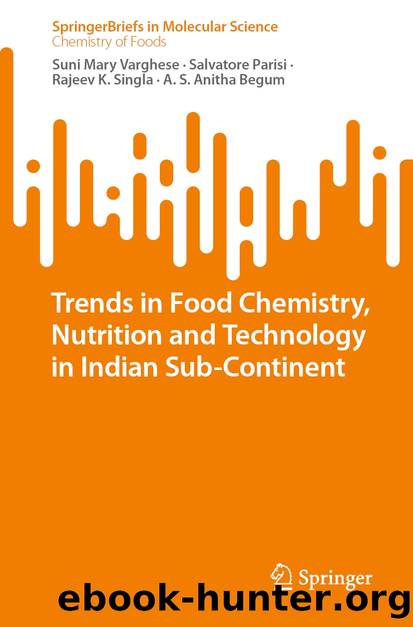Trends in Food Chemistry, Nutrition and Technology in Indian Sub-Continent by Suni Mary Varghese & Salvatore Parisi & Rajeev K. Singla & A. S. Anitha Begum

Author:Suni Mary Varghese & Salvatore Parisi & Rajeev K. Singla & A. S. Anitha Begum
Language: eng
Format: epub
ISBN: 9783031063046
Publisher: Springer International Publishing
5.3 Food Hazards in Terms of Physical, Chemical, or Biological Contaminants
Hazard is defined as âa biological, chemical or physical agent in food, including allergens, or a condition of food with the potential to cause an adverse health effectâ (CAC 1997). Unsafe food containing different pathogens and chemical dangerous substances are estimated many major human illnesses (WHO 2020). Food safety involves strategies and activities aimed to protect foods from biological, chemical, physical, and allergenic hazards.
Contamination can be intentional or contamination by chemicals such as pesticide residues, physical contaminants such as stones, metals, grits, or biological agents (Connolly et al. 2016; Michaelidou and Hassan 2008).
Toxins produced by moulds (mycotoxins) can be fatal as they have teratogenic, mutagenic, or carcinogenic effects. Amino acids of animal origin are broken down by bacteria to produce toxins like histamines and other biogenic amines that can cause foodborne illness. Environmental contaminants, metals, pesticide and drug residues, animals, birds, and rodents can cause contamination of food.
Food and water can transmit diseases and food infections, through food intoxication. Parasites and helminths can cause foodborne illnesses. With reference to specific microbial menaces of main importance, Listeria monocytogenes is an important foodborne pathogen. It is a causative agent of a severe infection that primarily affects immunocompromised people, pregnant women, and occasionally healthy people. Intrauterine infection of the foetus resulted in a dearth or an actually ill infant with a septic disseminated from listeriosis. Faecal pollution in food and water is the major cause of disease outbreaks, a significant number of novel genetic markers of faecal indicator bacteria have been identified (Zheng and Shen 2018).
A chemical hazard can cause immediate or long-term effects on consumption. Chemical hazards are common due to accidental spillage of permitted additives or Generally Recognized as Safe (GRAS) chemicals. GRAS may be dangerous especially if they exceed permissible levels. Usage of non-permitted additives is common in developing countries, where enforcement is delayed or neglected.
Any extraneous object or foreign matter in a food that causes illness or injury to a person on consumption is a physical hazard. Systems should be in place to prevent contamination of foods by foreign bodies such as glass, metal shards, etc., and unallowed/extraneous chemicals. In manufacturing and processing, suitable detection or screening devices should be used wherever necessary. The possible source of physical hazards may be identified by untrained operators (employees). The presence of non-food-related parts or contaminant materials can cause injury, wounds, and infections in the throat and intestine. Hence, due importance must be given to personnel hygiene, protective suits, gloves, footwear, head caps, facial masks, and proper use of jewellery.
Download
This site does not store any files on its server. We only index and link to content provided by other sites. Please contact the content providers to delete copyright contents if any and email us, we'll remove relevant links or contents immediately.
| Automotive | Engineering |
| Transportation |
Machine Learning at Scale with H2O by Gregory Keys | David Whiting(4182)
Never by Ken Follett(3791)
Urban Outlaw by Magnus Walker(3342)
OPNsense Beginner to Professional by Julio Cesar Bueno de Camargo(3251)
Sapiens and Homo Deus by Yuval Noah Harari(2987)
Will by Will Smith(2793)
A Short History of Nearly Everything by Bryson Bill(2629)
Hooked: A Dark, Contemporary Romance (Never After Series) by Emily McIntire(2502)
Rationality by Steven Pinker(2291)
Borders by unknow(2229)
The Becoming by Nora Roberts(2088)
Holy Bible (NIV) by Zondervan(2087)
The One Percenter Encyclopedia by Bill Hayes(1787)
HBR's 10 Must Reads 2022 by Harvard Business Review(1777)
Freedom by Sonny Barger(1771)
A Short History of War by Jeremy Black(1762)
Five Ways to Fall by K.A. Tucker(1700)
Go Tell the Bees That I Am Gone by Diana Gabaldon(1687)
Girls Auto Clinic Glove Box Guide by Patrice Banks(1685)
